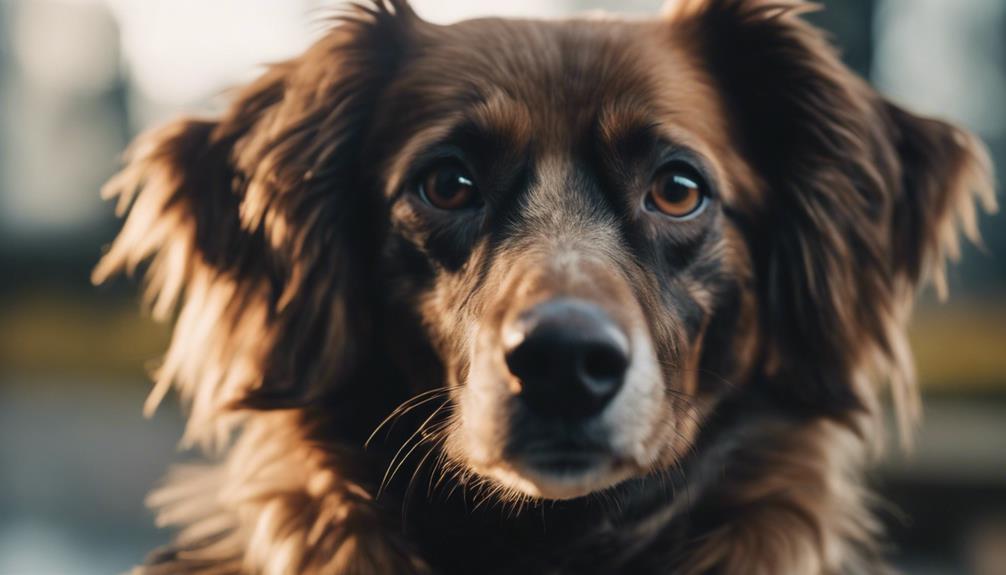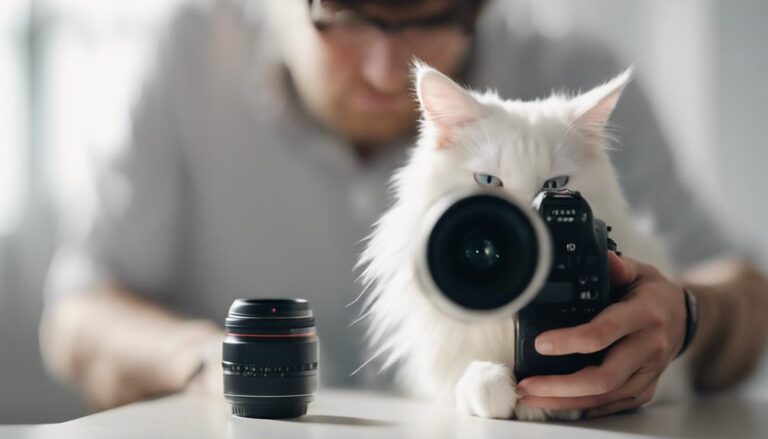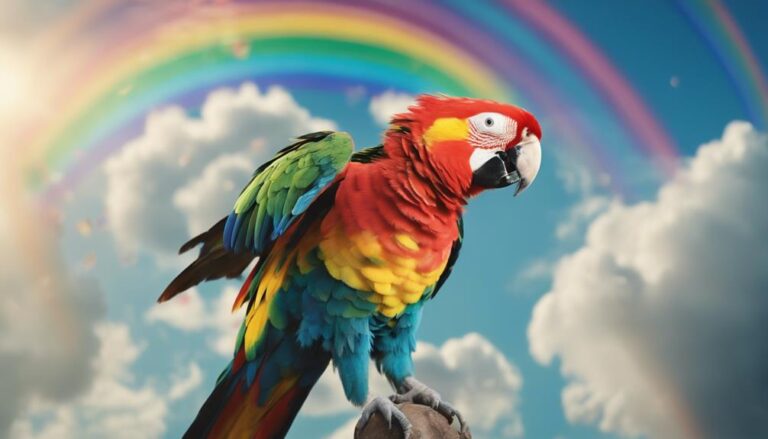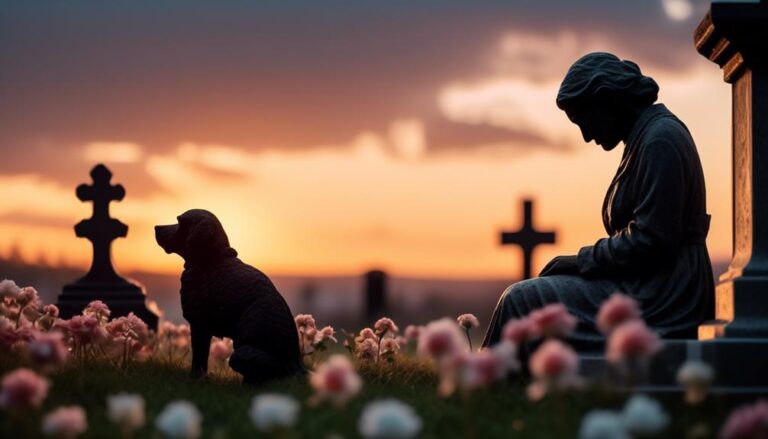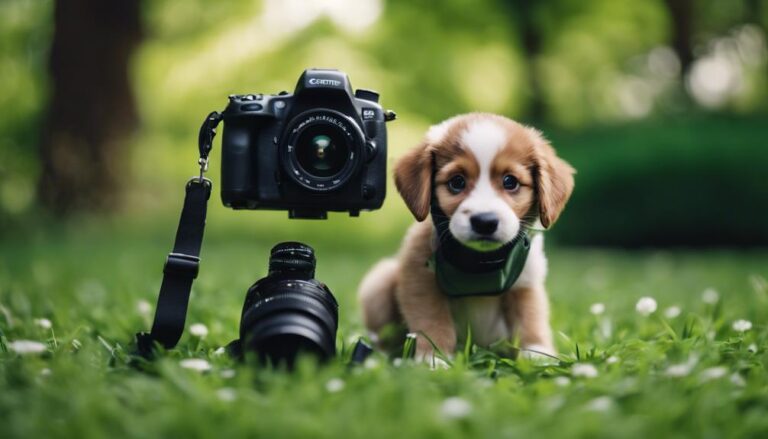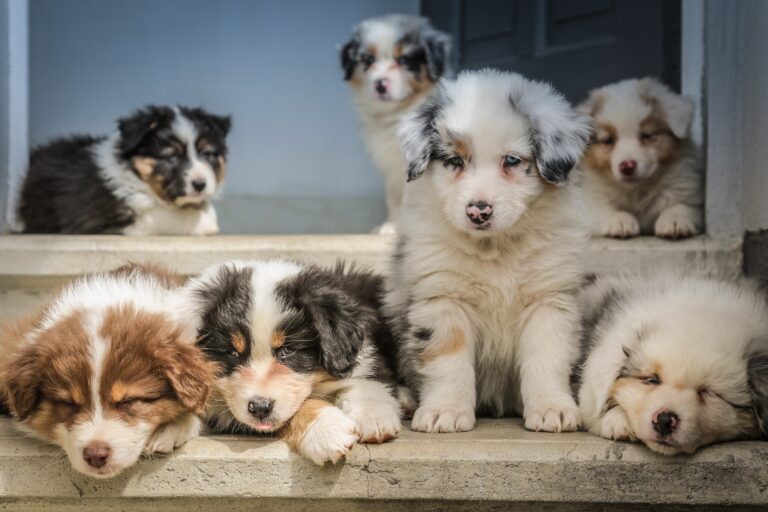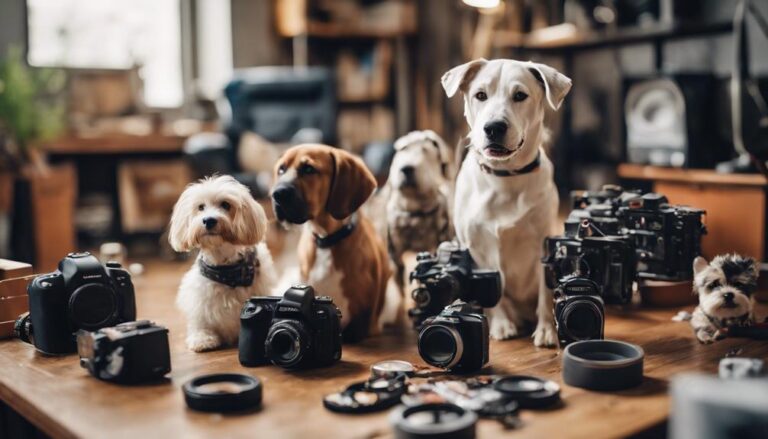Enhance your dog photography skills with specialized training. Learn to capture unique personalities, understand behavior, and master styling. Choose suitable camera gear, experiment with lighting, and focus on canine communication. Discover pricing strategies, marketing techniques, and effective client communication. Keep developing through continuing education opportunities. Ready to explore more about becoming a dog photography specialist?
Essential Skills for Dog Photographers
To excel as a dog photographer, you must master the art of capturing the unique personalities and characteristics of dogs through your lens. Understanding dog behavior is essential in capturing authentic moments that showcase their individuality. Dogs have their own quirks and habits, so being able to anticipate their actions can help you capture those spontaneous and genuine expressions that make for compelling photographs.
Composition techniques play an important role in creating visually appealing dog portraits. Pay attention to the background of your shots to make sure it complements the dog and doesn't distract from the main subject. Utilize leading lines to draw the viewer's eye towards the dog, emphasizing their presence in the frame. Experiment with different angles to find the most flattering perspectives that highlight the dog's features and personality.
When photographing dogs, consider their energy levels and adjust your shooting style accordingly. For high-energy dogs, fast-paced action shots can capture their dynamic nature, while for calmer dogs, you might focus on capturing serene moments that reflect their peaceful demeanor. By tailoring your approach to each dog's behavior, you can create a diverse portfolio that showcases the range of personalities within the canine world.
Mastering dog behavior and composition techniques will elevate your dog photography skills and enable you to capture engaging images that resonate with viewers.
Choosing the Right Camera Gear
Choosing the suitable camera gear is essential for achieving the best results in dog photography. When capturing stunning images of dogs, having the right camera settings and lens choices is key. Opt for a camera with a high megapixel count to guarantee sharp and detailed photographs, especially when printing large format images. Experimenting with different lenses can also add variety to your shots. Consider using a wide-angle lens for capturing expansive scenes or a telephoto lens for those up-close portraits with beautiful bokeh backgrounds.
In addition to camera settings and lens choices, mastering image composition and framing techniques is vital to creating visually appealing dog photographs. Pay attention to the rule of thirds, leading lines, and symmetry when composing your shots. Frame your furry subjects in a way that highlights their unique features and personalities. Experiment with different angles and perspectives to add depth and interest to your images.
Lighting Techniques for Dog Photography
Achieve enchanting and professional dog photographs by mastering effective lighting techniques. When it comes to dog photography, understanding the importance of lighting is essential. Natural lighting, such as sunlight, can create a warm and vibrant atmosphere in your photos. It is ideal for outdoor settings where you can take advantage of the natural light to illuminate your furry subject beautifully. Positioning your dog in a way that utilizes the natural light can result in stunning and authentic images capturing their essence.
On the other hand, artificial lighting can be a valuable tool, especially in indoor settings where natural light may be limited or inadequate. Soft, diffused artificial light sources like studio lights or softboxes can help create a well-lit and focused look for your dog photos. When using artificial lighting, be mindful of the intensity and direction of the light to avoid harsh shadows or overexposure.
Whether you are shooting outdoors or indoors, experimenting with different lighting techniques is key to finding what works best for the specific dog you are photographing. Pay attention to how light interacts with your dog's fur, eyes, and overall features to capture their unique personality effectively. Mastering the balance between natural and artificial lighting in different settings will elevate your dog photography skills to the next level.
Understanding Dog Behavior
Understanding dog behavior is essential for capturing genuine and expressive moments in your dog photography sessions. By being attuned to canine communication and behavioral cues, you can create compelling images that truly showcase the personality of the dogs you photograph.
Canine communication is a rich and nuanced field. Dogs express themselves through body language, vocalizations, and facial expressions. To capture the most authentic moments, pay attention to their tail wagging, ear position, and eye contact. A wagging tail doesn't always mean happiness; it can also indicate excitement or even anxiety. Similarly, ears held flat against the head might signal fear or submission. By interpreting these signals correctly, you can anticipate the right moments to click your camera shutter.
Behavioral cues offer valuable insights into a dog's mood and temperament. Dogs exhibit various behaviors like play bows, growling, or yawning, each carrying its own meaning. A play bow, with the front legs lowered and the rear end raised, often signifies an invitation to play. On the other hand, growling can indicate discomfort or aggression. Understanding these cues enables you to create a comfortable and safe environment for the dogs during the photoshoot, leading to more natural and impactful photographs.
Styling and Posing Dogs
When styling and posing dogs for photography, remember to focus on bringing out their unique characteristics. Use various posing techniques to showcase different angles and expressions. Get creative with dog poses to capture their personalities in a memorable way.
Styling for Dog Photos
To capture stunning dog photos, consider the styling and grooming tips that will enhance your furry subject's natural charm and personality. Dog fashion plays an important role in creating visually appealing images. Choose outfits that complement the dog's fur color and style, avoiding overly distracting patterns. Simple accessories like bandanas or bows can add a touch of personality without overwhelming the photo. When it comes to grooming, make sure the dog is clean and well-groomed before the photoshoot. Brush out any tangles or mats, trim excess fur if needed, and clean their eyes and ears for a polished look. By paying attention to dog fashion and grooming, you can elevate your photos and showcase the unique beauty of each canine model.
Posing Techniques for Dogs
Enhance your dog photography skills by mastering essential posing techniques that highlight your furry subjects' unique personality and charm.
- Capture Action: Showcase your dog's agility by photographing them in motion. Freeze moments of excitement and energy to add dynamism to your shots.
- Embrace the Outdoors: Take advantage of outdoor adventures to capture your dog in natural settings. Utilize natural light and the beauty of nature to enhance your photos.
- Show Personality: Encourage natural behavior to capture your dog's true essence. Whether it's a playful stance or a curious look, focus on showcasing their individuality in each photo.
Creative Dog Poses
Capture stunning and unique dog poses that showcase their personality and charm by exploring different styling and posing techniques. To achieve this, focus on playful interactions and artistic expressions to bring out the best in each dog. Incorporating natural elements like parks or beaches can add depth to the images, while abstract concepts such as using props creatively can enhance the visual interest. Encourage dogs to express themselves naturally, whether it's through a quirky tilt of the head or a playful jump. Experiment with angles, lighting, and settings to create compelling compositions. Remember, the goal is to convey the essence of each dog in a way that is both visually appealing and emotionally engaging.
Editing Tips for Stunning Dog Portraits
When editing dog portraits, concentrate on lighting to establish the mood, utilize color correction techniques for vibrant images, and enhance backgrounds to make your photos stand out. These three points will help you elevate your dog photography to the next level and capture striking portraits that impress. Experiment with these editing techniques to create compelling and professional-looking images of dogs.
Lighting for Mood
Crafting an enchanting atmosphere through strategic lighting choices can elevate the mood of your dog portraits, enhancing their visual appeal and emotional impact. When considering lighting for your dog photography, remember the following:
- Natural vs Artificial Lighting: Natural light can create a soft and warm feel, ideal for outdoor shoots, while artificial light offers consistency and control indoors. Experiment with both to see what suits your vision best.
- Using Shadows Creatively: Shadows can add depth and drama to your images. Play with different angles and intensities of light to create intriguing shadow patterns that complement your furry subject.
- Balancing Light and Shadows: Finding the right balance between light and shadows is essential. Too much light can wash out details, while too many shadows can obscure your dog's features. Strike a harmonious equilibrium for captivating portraits.
Color Correction Tricks
Enhancing the color balance in your dog portraits through strategic editing techniques can truly make your images pop and stand out. When it comes to color correction tricks, mastering color grading techniques is essential for impactful image enhancement. During your post-production workflow, using editing software like Adobe Photoshop or Lightroom can help you achieve the desired color balance. Experiment with adjusting the white balance, saturation, and contrast to bring out the vibrancy in your dog portraits. Pay attention to subtle details like fur color and eye tones, ensuring they appear natural and appealing. By incorporating these color correction tricks into your editing process, you can elevate the quality of your dog photography to new heights.
Background Enhancement Ideas
To elevate the visual impact of your dog portraits, consider implementing background enhancement ideas during the editing process.
- Background retouching, composition: Adjust the background to complement your dog subject. Remove distractions, adjust colors, or blur the background to create a more cohesive composition.
- Creative filter effects, enhancing textures: Experiment with creative filter effects to add depth and interest to the background. Enhancing textures like grass, leaves, or walls can bring out unique details that enhance the overall aesthetic.
- Lighting adjustments: Modify the lighting in the background to create a more dramatic or soft ambiance. Play with shadows, highlights, and exposure to enhance the mood and draw attention to your furry model.
Building a Portfolio of Canine Clients
To attract a diverse range of canine clients for your photography portfolio, focus on showcasing your ability to capture each dog's unique personality and charm. Building strong client relationships is crucial in the dog photography business. Networking within the local dog community can help you connect with potential clients. Attend dog-related events, visit dog parks, and reach out to local pet businesses to spread the word about your services.
When building your portfolio, consider location scouting for outdoor shoots. Outdoor settings provide a natural and comfortable environment for dogs, allowing you to capture them in their element. Look for parks, beaches, or even urban settings that can add depth and interest to your photos. Different locations can also help showcase your versatility in capturing dogs in various environments.
Each dog has its own personality, so it's vital to tailor your approach to each client. Spend time getting to know the dog before the shoot to establish trust and rapport. This will help you capture authentic expressions and behaviors, resulting in more compelling photos for your portfolio. Remember, happy clients are likely to refer you to other dog owners, further expanding your portfolio of canine clients.
Pricing Your Dog Photography Services
Consider setting competitive prices for your dog photography services based on factors such as your experience, location, and the unique value you offer to clients. When determining the pricing for your services, it's vital to take into account various aspects to make sure that your pricing strategy aligns with your business goals and attracts potential clients effectively.
To establish the right pricing for your dog photography services, you should focus on the following key points:
- Pricing Strategies: Explore different pricing models such as packages, hourly rates, or session fees to find the most suitable approach for your business. Consider the costs involved in running your photography sessions, including equipment, editing software, and travel expenses, while ensuring your prices reflect the value you provide to your clients.
- Branding: Your pricing should align with your branding strategy. If you position yourself as a high-end dog photographer offering exclusive services, your prices should mirror this positioning. Conduct a thorough competition analysis to understand how other dog photographers in your area price their services and adjust your rates accordingly.
- Client Satisfaction: While pricing is important, ensuring client satisfaction is equally essential. Offer excellent customer service, deliver high-quality images, and build strong relationships with your clients to justify your pricing and encourage repeat business and referrals. Prioritize client satisfaction to establish a loyal customer base that values your work.
Marketing Strategies for Dog Photographers
To effectively market your dog photography services, start by identifying your target audience and tailoring your promotional efforts to reach them. Utilize social media platforms to showcase your work, engage with potential clients, and create a strong online presence. By focusing on these strategies, you can attract more customers and grow your dog photography business.
Target Audience Identification
Identifying your target audience is essential for successful marketing strategies as a dog photographer. When defining your target market, consider conducting competition analysis to understand what sets you apart. To effectively reach your audience, implement tailored marketing strategies that resonate with dog owners. Utilize branding techniques to establish a unique identity and build trust with potential clients. By identifying your target audience, you can focus your efforts on engaging with those who are most likely to appreciate your services. This targeted approach not only helps in attracting the right clientele but also enhances customer satisfaction by delivering specialized services that cater to the specific needs of dog owners.
Social Media Promotion
When expanding your reach as a dog photographer, leveraging the power of social media can greatly elevate your visibility and attract potential clients interested in your unique photography style. To boost your online presence, consider collaborating with pet influencers to showcase your work to a broader audience. Stay updated on social media algorithms to make certain your content reaches more viewers organically. Implement effective hashtag strategies to increase the discoverability of your posts among dog-loving communities. Engaging with your followers through interactive posts, contests, and behind-the-scenes glimpses can foster a loyal client base. By mastering these engagement tactics, you can build relationships with your audience, ultimately leading to more inquiries and bookings for your dog photography services.
Client Communication and Expectations
Establishing clear communication and setting realistic expectations with your clients is crucial for a successful dog photography session. When it comes to client communication and expectations in dog photography, here are three key points to keep in mind:
- Client Satisfaction: Prioritize open and honest communication with your clients from the initial inquiry to the delivery of the final product. Listen attentively to their preferences, ideas, and concerns to make sure you grasp their vision for the shoot. By actively engaging with your clients, you can build trust and rapport, leading to higher levels of satisfaction with the end results.
- Managing Expectations: Be transparent about what clients can anticipate from the photography session regarding outcomes and timelines. Clearly outline the process, including details such as the number of edited photos they will receive, the turnaround time for delivering the final images, and any additional services you offer. Managing expectations effectively can help prevent misunderstandings and ensure that clients are happy with the final product.
- Results: Deliver on your commitments and aim to exceed client expectations with the quality of your work. Consistent communication throughout the process and delivering high-quality images that capture the essence of their beloved pets will leave a lasting impression and lead to satisfied clients who are likely to recommend your services to others.
Continuing Education and Professional Development
To enhance your skills and stay current in the field of dog photography, investing in continuing education and professional development opportunities is essential. Online courses offer a convenient way to learn new techniques, editing skills, and business strategies from the comfort of your home. Look for courses that focus specifically on dog photography to gain specialized knowledge that can set you apart in the industry. These online resources can help you improve your photography skills, understand animal behavior for better shoots, and enhance your overall business acumen.
Networking events are another valuable avenue for professional growth in dog photography. Attending industry conferences, workshops, or local meetups can provide opportunities to connect with other photographers, learn from experts in the field, and potentially collaborate on projects. Building a strong network of fellow dog photographers can lead to referrals, mentorship opportunities, and exposure to new trends in the industry. Additionally, networking events can help you stay motivated and inspired by surrounding yourself with like-minded individuals who share your passion for capturing stunning images of dogs.
Frequently Asked Questions
Can I Specialize in a Specific Breed of Dog as a Dog Photography Specialist?
Yes, you can specialize in a specific breed of dog as a dog photography specialist. By focusing on a breed, you can tailor your marketing strategies to attract clients interested in showcasing their beloved pets, offering specialized services.
How Can I Ensure the Safety and Comfort of the Dogs During a Photoshoot?
Guarantee the safety and comfort of the dogs during a photoshoot by utilizing gentle handling techniques and implementing safety measures. Establish a peaceful setting with appropriate lighting techniques to help the dogs feel at ease and capture their best moments.
What Are Some Creative Ways to Incorporate Props or Accessories in Dog Photography?
For creative dog photography, try using props like hats or toys to add personality. Indoors offer controlled settings, while outdoors provide natural backdrops. Mix classic and modern styles for a trendy twist. Experiment with vintage accessories for unique shots.
How Can I Attract More Clients Who Are Interested in Having Professional Photos Taken of Their Dogs?
To attract more clients for professional dog photos, focus on social media promotion and networking. Engage with pet-loving communities, use eye-catching visuals, and offer special promotions. Build relationships through client outreach and implement effective marketing strategies to grow your clientele.
Are There Any Legal Considerations or Contracts I Should Have in Place When Working With Dog Photography Clients?
When working with dog photography clients, it's vital to have legal protections in place. Guarantee client confidentiality with contracts. Clearly outline payment terms, obtain model releases, and have liability waivers to safeguard your business.
Conclusion
To sum up, mastering the art of dog photography requires a combination of essential skills, the right camera gear, lighting techniques, understanding dog behavior, styling and posing dogs, pricing your services, effective marketing strategies, client communication, and ongoing professional development. By honing your craft and continuously learning and growing as a dog photographer, you can provide exceptional services and capture unforgettable moments for your clients. Keep practicing and perfecting your skills to truly stand out in this specialized field.

